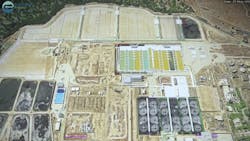Treatment plant design made easier
Key Highlights
- Digital twins create a digital replica of treatment plants, improving collaboration among process, geotechnical, structural, electrical, and control engineers.
- Early clash detection in a shared 3D model prevents costly construction errors and reduces project delays.
- 4D visualization adds the element of time, allowing project managers to monitor progress and identify bottlenecks before they impact schedules.
The job of designing water and wastewater treatment plants is not easy. Managing any large construction design project has been compared to a conductor directing an orchestra where every musician belonged to a different union. Design is spread across many engineering disciplines. Nowadays, however, treatment plant design can be made easier by leveraging digital design and the overall concept of a “digital twin."
A digital twin can be thought of as two views of the treatment plant — one is the actual, physical facility with its real tanks, pumps and other equipment, the second being digital software that looks and behaves like the real system but only digitally. During the design phase of a project, only the digital representation of the plant exists. As construction moves on, the physical plant is born and matures to match the digital twin. Once constructed, the two versions can go through life hand-in-hand, each doing what each does best.
The design of a treatment plant requires engineers with expertise in process design, geotechnical, building, hydraulic, structural, electrical and control engineers to work together, bringing their expertise to the job. In the past, bringing these skills together was difficult. Each discipline had its own software and needed to place its equipment within the overall plant.
This led to the inevitable clashes between disciplines and the development of clash detection software. While this would eventually work, wouldn’t it be better if all of the disciplines worked on the same 3D model of the finished plant? Clashes could be avoided before they occurred. This is where the value of a 3D digital twin of a plant shows up. The work of each discipline could be merged together into a single consistent 3D view. No longer will a mechanical engineer place a pump at the same location where an electrical engineer put a motor control center, and where the structural engineer placed a column. The clash could be detected and resolved early on, and all the disciplines would benefit, saving time and money.
But don’t engineers just love showing up at meetings and walking around construction sites with a 6-inch diameter roll of construction drawing sheets under their arms? (Design software can still produce drawing sheets for those who want them.) Digital twins make things less cumbersome. Enngineers can open their laptop and view their work in 3D while sharing with the team. There would be no need to cut down trees to produce the final plans or all the draft plans along the way.
The value of a digital twin doesn’t end once the project goes out to bid. Shop drawing reviews can also find places where a better product with a different footprint may save time and money. Change orders crop up with even the best designs and digital twins can be edited instantly once they are approved, while old versions can be saved eliminating the need to store huge rolls of paper.
Once construction project managers learn to use digital twins, they realize how digital twins can make their jobs more manageable. For those who think that 3D visualization is the ultimate tool, wait until you see 4D.
The fourth dimension is time. It’s possible for project managers to watch their treatment plants grow digitally from bare ground to a completed plant. Interested in wanting to know how far along construction will be on September 14? Run the digital twin model and it will show what the site will look like on that day. If the actual project doesn’t look like the digital twin, the project manager can see the bottleneck and take steps to avoid an issue before it throws the entire project off schedule.
Once construction is complete, the owner or operator can put away the digital twin, right? That’s true if all that’s needed is to have a compete record drawing of the plant. But there is more to digital twins. The twin becomes the basis for plant operation and maintenance. The operator can click on a pump in the 3D display and download all the pump’s data, such as static information like model number, year installed, manufacturer. But even better, the digital twin can serve up operational data such as flow, head, suction and discharge pressure, vibrations and efficiency or maintenance data such as dates of past and planned work orders.
Now you can rest, right? Wrong. Because the plant will need to be upgraded to handle population growth, updated to meet new regulations, or rehabilitated to replace aging equipment. The engineers don’t need to start the design from scratch if the existing plant was based on a digital twin. (If it doesn’t exist, it can be created by flying a drone around the plant and to create a digital twin that is up to date.) Using the up-to-date digital twin, the design work can be done for less cost than the original digital twin and dramatically less than if the original design was on paper sheets.
What kind of software does this? There isn't only a single software product that can, but one example is Bentley Systems, Treatment Plant Solution. The solution is made up of a variety of products that cover the spectrum of disciplines involved; structural, geotechnical, hydraulic, electrical, controls and whatever other software can be used to develop the digital twin. The software doesn’t even need to be Bentley Systems software as the nature of this software solutions is its openness. It is just one of a growing collection of solutions that solve a wide variety of industry problems from engineering to construction, to operation and maintenance across many industries.
Designing and operating a water or wastewater treatment plant may never be easy but using a digital twin tool for 3D and 4D models of facilities can make it much easier.



